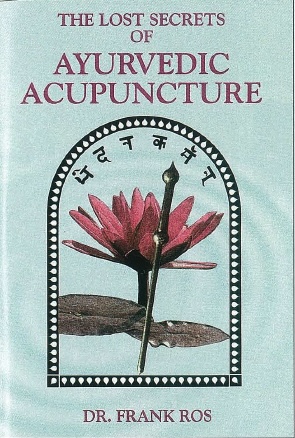Pointed Healing
By Neesha Alahan
Acupuncture, the use of needles inserted into critical points of the body to stimulate healing, has long been thought of as primarily Chinese in origin. However, other Asian countries developed similar healing methods utilizing pressure points on the body. In The Lost Secrets of Ayurvedic Acupuncture (207 pages, Lotus Press, us$15.95), Dr. Frank Ros, director of the Australian Institute of Ayurvedic Medicine, reveals a virtually unknown form of acupuncture in Indian Ayurveda. Ros learned of the healing method while studying an ancient Indian martial art called Kalari. This highly effective form of self-defense, still practiced in Kerala, has an extensive system of healing as part of advanced training. Besides herbology, Kalari medicine utilizes knowledge of the weak points and nerve meridians (called marmas) used in fighting techniques, to heal battle wounds and maintain optimum physical condition. This knowledge has been passed from the Kalari master to the most trusted students through word of mouth for centuries, which explains why it is still largely unknown. The book details the many similarities between Chinese acupuncture and ayurvedic acupuncture, traditionally termed bhedan karma (meaning “piercing-through therapy”). Beginning with the basics of ayurveda, Ros describes the energy channels, or nadis, and the marmas, or vital points, and the symptoms they treat. Ros has brought to life a closely guarded treasure of highly effective holistic healing. His book is a useful tool for those interested in acupuncture as a solution to health troubles.
The Lost Secrets of Ayurvedic Acupuncture by Dr. Frank Ros, Lotus Press, P.O. Box 325, Twin Lakes, Wisconsin 53181, USA.
Ammachi’s Biography
By Sitara Alahan, Kapaa, Hawaii
The biography of “the hugging saint,” Amma, Healing the Heart of the World, by Judith Cornell (271 pages, Harper Collins Publishers, Inc., us$24.00) is the story of Mata Amritanandamayi’s life. The book’s first section recounts Amma’s childhood and the challenges she faced. Born in a small fishing village, Amma was held in low esteem because of her dark skin. Being forced to work as a servant for her family, she composed and sang songs to Krishna while she toiled. When her mother fell ill, Amma was taken out of school and had to work full time. Often people thought she was crazy because of her constant devotion and seemingly thoughtless generosity. If she saw someone in need, Sudhamani (as Amma was known when she was young) would give them anything she had on hand, even when it didn’t belong to her. The second section of the book lists Amma’s accomplishments as an adult, after general recognition of her spiritual attainment and her efforts to spread love and spirituality throughout the world. It includes the testimonies of some of her closest followers and initiates. The book’s author, raised on stories of Christian saints, offers comparisons between the mystics of Christianity and those of Hinduism in small paragraphs which pop up throughout the book. Through the interviews with Amma’s family and followers, the author shows us the life of one of the modern world’s great religious leaders.
Amma, Healing the Heart of the World by Judith Cornell, Harpercollins Publishers, Inc. 10 East 53rd Street, New York, NY 10022, USA. web:www.harpercollins.com.
Veggie Answers
By Priya Alahan, Kapaa, Hawaii
Where can I find vegan marshmallows?” is the very first “Frequently Asked Question” in the book, Vegetarian & Vegan FAQ by Davida Gypsy and Reed Mangels (272 pages, The Vegetarian Resource Group, us$15.00). The answer to this apparently pressing issue among VRG’s website visitors is, unfortunately, “You can’t,”all commercial marshmallows contain gelatin, derived from animal bones. Hundreds more questions follow with all of the common hows, whats and whys answered in detail, along with reference books and websites for more information. Many questions deal with finding vegan products, meaning those containing no animal substances at all, including dairy products. Get the scoop on vegetarian gummy bears, wine, nonleather shoes, fake fur, soaps, candles, film, medical products, and much, much more. There’s a question about tatoo ink, which is OK, but the liquid used to get the ink out of the gun and into your body may be animal based. Another is on whether dogs and cats can be vegetarianÑeasier for a dog, but more difficult for a cat. There’s even a question on vegan donuts, which refers readers to Pangea, a store that carries several types of donuts, of which the editors note that the soy “yogurt” ones are especially good. With their humorous yet sensible answers, Gypsy and Mangels’ book is fun, interesting and useful for vegan and vegetarian alike.
Vegan and Vegetarian FAQ by Davida Gypsy and Reed Mangels PHD, Vegetarian Resource Group, PO Box 1463 Baltimore, Maryland 21203, USA. web: www.vrg.org.
